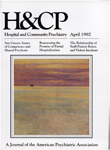Impact of Borderline Personality Disorder in Late Life on Systems of Care
Abstract
Some symptoms that are benchmarks of borderline personality disorder in the younger patient—identity disturbance, impulsivity, self-mutilation, risk taking, and substance abuse-do not appear to define the disorder in late life. However, changes in the environment or social context of elderly persons may cause core symptoms to manifest differently. identity disturbance in old age may be evidenced by an inability to formulate future plans or pursue goal-direct-ed activities. Anorexia may be a substitute for more obvious forms of self-mutilation. Elderly patients with severe personality disorders may disrupt nursing homes and other service delivery systems. The authors suggest that staff who work with these patients receive special training and that more research is needed to identify which symptoms of personality disorders are maintained into old age.
Access content
To read the fulltext, please use one of the options below to sign in or purchase access.- Personal login
- Institutional Login
- Sign in via OpenAthens
- Register for access
-
Please login/register if you wish to pair your device and check access availability.
Not a subscriber?
PsychiatryOnline subscription options offer access to the DSM-5 library, books, journals, CME, and patient resources. This all-in-one virtual library provides psychiatrists and mental health professionals with key resources for diagnosis, treatment, research, and professional development.
Need more help? PsychiatryOnline Customer Service may be reached by emailing [email protected] or by calling 800-368-5777 (in the U.S.) or 703-907-7322 (outside the U.S.).



